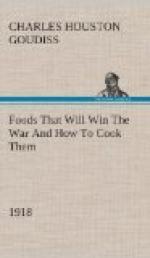3-1/2 cupfuls of flour (this includes added cereals) 1 cupful of water or milk 1/2 tablespoon shortening 1-1/2 teaspoons salt 1 cake of compressed yeast
In this recipe sugar has been omitted because of the serious shortage, but after the war a teaspoon of sugar should be added. The shortening, although small in quantity, may also be omitted.
These materials make a loaf of about one pound, which should be baked in forty to fifty minutes at a temperature of 450 degrees (Fahrenheit). Allow a little longer time for bread containing oatmeal or other grains. Such breads require a little longer baking and a little lower temperature than wheat breads. If you do not use a thermometer in testing your oven, place a piece of paper on the center shelf, and if it browns in two minutes your oven is right. If a longer period for raising is allowed than is suggested in the above recipe, the yeast proportion should be decreased. For overnight bread use one-quarter yeast cake per loaf; for six-hour bread, use one-half yeast cake per loaf; for three-hour bread, use one yeast cake per loaf. In baking, the time allowed should depend on the size of the loaf. When baked at a temperature of 450 degrees, large loaves take from forty-five to sixty minutes, small loaves from thirty to forty minutes, rolls from ten to twenty minutes.
It is well to divide the oven time into four parts. During the first quarter, the rising continues; second quarter, browning begins; the third quarter, browning is finished; the fourth quarter, bread shrinks from the side of the pan. These are always safe tests to follow in your baking. When baked, the bread should be turned out of the pans and allow to cool on a wire rack. When cool, put the bread in a stone crock or bread box. To prevent staleness, keep the old bread away from the fresh—scald the bread crock or give your bread box a sun bath at frequent intervals.
Even with all possible care to prevent waste, yeast breads will not conserve our wheat supply so well as quick breads, because all yeast breads need a larger percentage of wheat. The home baker can better serve her country by introducing into her menus numerous quick breads that can be made from cornmeal, rye, corn and rye, hominy, and buckwheat. Griddle cakes and waffles can also be made from lentils, soy beans, potatoes, rice and peas.




